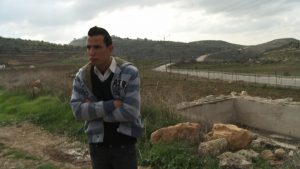Ben Ehrenreich’s Way to the Spring
I recommend Ben Ehrenreich’s new work of in-depth and personal reporting, The Way to the Spring: Life and Death in Palestine. Ehrenreich spent two years off and on visiting Nabi Saleh, a Bedouin village and Hebron – staying in those flashpoints while also living in Ramallah. I met Ehrenreich briefly in Nabi Saleh while we were filming Holy Land, and I remember his compelling NY Times magazine cover story on Nabi Saleh – Is This Where the Third Intifada Will Start. The book offers the fullest exploration I’ve read of the human, social, cultural and political dimensions of life today in the Palestinian West Bank. Given the extent of coverage of Israeli policies and actions in the West Bank, it’s struck me as strange that there hasn’t been deeper, more probing exploration of daily life in Palestine, or more fully rounded profiles of Palestinians engaged in resistance to the occupation, such as Bassem Tamimi of Nabi Saleh, one of the central figures in Ehrenreich’s book.
Ehrenreich’s prose is powerful and often poetic. He’s passionate — the book is a new and angry denunciation of the occupation, a fresh indictment based on the evidence the author gathered in his time logged in Nabi Saleh demonstrations and other resistance activities he observed or joined with. It’s meaningful and important to note that he is equally impassioned in his critique of the Mahmoud Abbas and the sclerotic, ineffectual and the entrenched leadership of the Palestinian Authority.
It was fascinating for me to read such a detailed account of a place where I have also spent a good deal of time, and made many friends. I found that the book truly captured the nuance and spirit of Nabi Saleh and its people. My main quibble is that I find it surprising that Ehrenreich gives no voice to the Islamist factions in Palestine — particularly Hamas. He notes in the introduction: “For reasons of both access and affinity, I spent little time among adherents of political Islam.” I think the book would have been better had at least one of its major subjects been with Hamas — which is, after all, the consistently most popular political force in Palestine. However, no single book or film can cover everything — there’s always a painful process of omission.
What I find most striking is that Ehrenreich settled on a small water spring, located near Nabi Saleh, as the central metaphor of the book. It’s a place that drew me as well. In my own time in Nabi Saleh, images of that place also struck me as a powerful illustration of the beauty of the land, and as a symbol of what the peoples who live there should share together, if not for the tragedy of the conflict. The spring is known as Ein al-Qaws (an alternate spelling is Ein al-Qoos), or the bow spring. The spring sits across the two-lane highway that separates Nabi Saleh from the settlement of Halamish. The settlers claim that spring was an abandoned mud puddle that they have restored. Most independent observers, including some Israeli officials, declare that the spring was illegally confiscated by the settlers.
Here is an interview we did with Mohammad Tamimi at the spring. Mohammad is a journalist, social networker and resistance leader from Nabi Saleh.
Mohammad Tamimi – The Spring from Peter Cohn on Vimeo.
It’s a beautiful place. Here are some pictures:












0 Comments